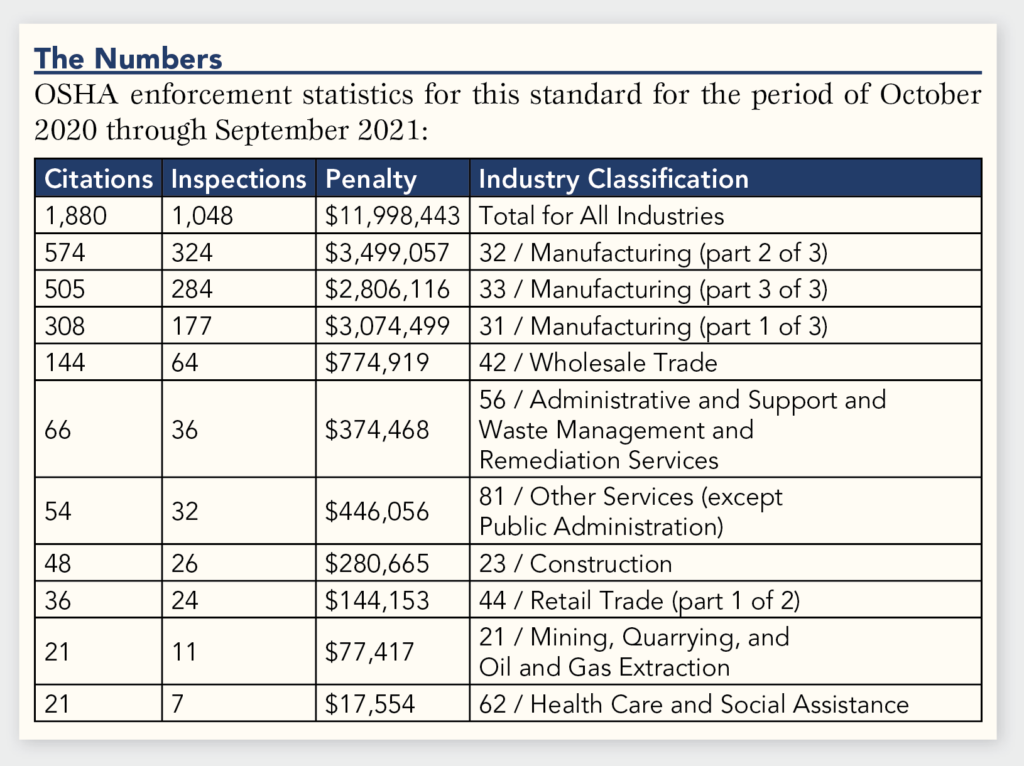OSHA Standard 29 CFR 1910.147: Control of Hazardous Energy (Lockout/Tagout)
Ranking: #6
Energy sources including electrical, mechanical, hydraulic, pneumatic, chemical, thermal or other sources in machines and equipment can be hazardous to workers. During the servicing and maintenance of machines and equipment, the unexpected startup or release of stored energy can result in serious injury or death to workers. Injuries may include electrocution, burns, crushing, cutting, lacerating, amputating or fracturing body parts, and others. Craft workers, electricians, machine operators and laborers are among the millions of workers who service equipment routinely and face the greatest risk of injury. Proper lockout/tagout (LOTO) practices and procedures safeguard workers from hazardous energy releases.
Major Provisions of the Standard
This standard covers the servicing and maintenance of machines and equipment in which the unexpected energization or startup of the machines or equipment, or release of stored energy, could harm employees. It establishes minimum performance requirements for the control of such hazardous energy.
Minor tool changes and adjustments, and other minor servicing activities, which take place during normal production operations, are not covered by this standard if they are routine, repetitive, and integral to the use of the equipment for production, provided that the work is performed using alternative measures which provide effective protection.
- Employers must establish a program and utilize procedures for affixing appropriate lockout devices or tagout devices to energy isolating devices, and to otherwise disable machines or equipment to prevent unexpected energization, startup or release of stored energy in order to prevent injury to employees. Employers are also required to train each worker to ensure that they know, understand, and are able to follow the applicable provisions of the hazardous energy control procedures. Workers must be trained in the purpose and function of the energy control program and have the knowledge and skills required for the safe application, usage, and removal of the energy control devices.
- If an energy isolating device is not capable of being locked out, the employer’s energy control program shall utilize a tagout system.
- If an energy isolating device is capable of being locked out, the employer’s energy control program under paragraph shall utilize lockout, unless the employer can demonstrate that the utilization of a tagout system will provide full employee protection.
- Whenever replacement or major repair, renovation or modification of a machine or equipment is performed, and whenever new machines or equipment are installed, energy isolating devices for such machine or equipment shall be designed to accept a lockout device.
- When a tagout device is used on an energy isolating device which is capable of being locked out, the tagout device shall be attached at the same location that the lockout device would have been attached, and the employer shall demonstrate that the tagout program will provide a level of safety equivalent to that obtained by using a lockout program.
- In demonstrating that a level of safety is achieved in the tagout program which is equivalent to the level of safety obtained by using a lockout program, the employer shall demonstrate full compliance with all tagout-related provisions of this standard together with such additional elements as are necessary to provide the equivalent safety available from the use of a lockout device. Additional means to be considered as part of the demonstration of full employee protection shall include the implementation of additional safety measures such as the removal of an isolating circuit element, blocking of a controlling switch, opening of an extra disconnecting device, or the removal of a valve handle to reduce the likelihood of inadvertent energization.
- Procedures shall be developed, documented and utilized for the control of potentially hazardous energy when employees are engaged in the activities covered by this section.
- The procedures shall clearly and specifically outline the scope, purpose, authorization, rules, and techniques to be utilized for the control of hazardous energy, and the means to enforce compliance including, but not limited to, the following:
- A specific statement of the intended use of the procedure;
- Specific procedural steps for shutting down, isolating, blocking and securing machines or equipment to control hazardous energy;
- Specific procedural steps for the placement, removal and transfer of lockout devices or tagout devices and the responsibility for them; and
- Specific requirements for testing a machine or equipment to determine and verify the effectiveness of lockout devices, tagout devices, and other energy control measures.
- Locks, tags, chains, wedges, key blocks, adapter pins, self-locking fasteners, or other hardware shall be provided by the employer for isolating, securing or blocking of machines or equipment from energy sources.
- Lockout devices and tagout devices shall be singularly identified; shall be the only devices(s) used for controlling energy; shall not be used for other purposes; and shall meet the following requirements:
- Lockout and tagout devices shall be capable of withstanding the environment to which they are exposed for the maximum period of time that exposure is expected.
- Tagout devices shall be constructed and printed so that exposure to weather conditions or wet and damp locations will not cause the tag to deteriorate or the message on the tag to become illegible.
- Tags shall not deteriorate when used in corrosive environments such as areas where acid and alkali chemicals are handled and stored.
Compliance Resources
OSHA’s Lockout/Tagout Fact Sheet describes the practices and procedures necessary to disable machinery or equipment to prevent the release of hazardous energy. Access it here: https://tinyurl.com/33mabu9d WMHS
Sponsors:
800-832-8379 • www.avery.com
1-888-326-9244 • www.graphicproducts.com/guides/lockout-tagout-loto/






